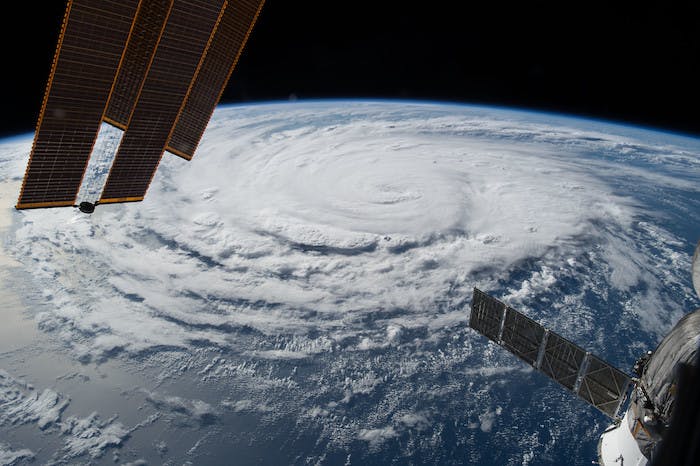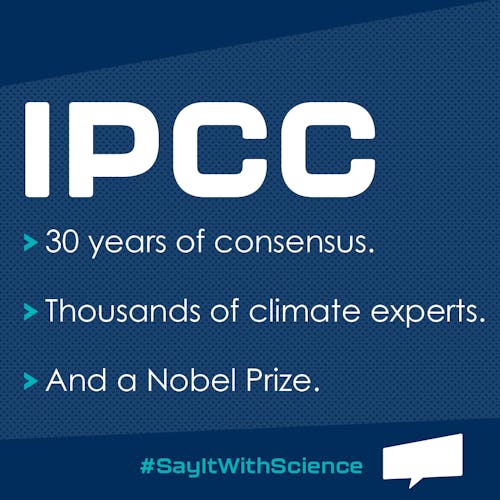When we all understand the facts of climate change, we can work together to find the best solutions. That’s why the UN Foundation is drawing on the gold standard in climate science — the Intergovernmental Panel on Climate Change — to create Say It With Science. To launch the initiative, we’re equipping young climate champions everywhere with the knowledge and tools they need to drive their activism and combat misinformation. People everywhere are joining the fight for urgent climate action. We’re stronger when we unite and #SayItWithScience.
2021 is a make or break year in the fight against climate change. This is the year in which countries need to deliver more ambitious commitments to cut their share of global greenhouse gas emissions in time for the COP26 conference, hosted by the UN Framework Convention on Climate Change in Glasgow in November. It’s the year in which we need to grow the global coalition of governments, companies, and organizations committed to achieving net-zero emissions and make sure they back up those promises with concrete plans. It’s the year we must build back from COVID-19 in ways that put us on the path to overcome the climate crisis and achieve the Sustainable Development Goals.
People everywhere, from young activists in every corner of the world, to civil society organizations, to global companies, to governments — including, once again, the U.S. — are speaking out on the urgent need for greater climate action. Our voices are more powerful when we unite around the irrefutable science that underscores the urgency of the moment and can drive practical, scalable solutions. That’s why we created Say It With Science.
“I don’t want you to listen to me,” Greta Thunberg told U.S. lawmakers in 2019. “I want you to listen to the scientists.”
The facts of climate change tell a clear story
For more than 30 years, thousands of the best climate scientists from across the world have taken part in the UN’s Intergovernmental Panel on Climate Change (IPCC) to carefully compile and analyze the latest and best climate-related data and research to arrive at consensus-based conclusions. The science may be complicated, but the facts tell a clear story. Over the years, IPCC scientists have expressed increasing certainty that climate change is real and happening right now, and that humans are causing it. For example, thanks to the IPCC, we know that the earth has warmed by 1.2°C (2.1°F) since preindustrial times (before 1850). While that may not sound like much, it has already caused devastation around the planet, including rising sea levels and an increase in the frequency and intensity of snowstorms, flooding, and other extreme weather events. In fact, natural disasters occur three times as often today as they did 50 years ago. It’s because of climate research by the IPCC that we can confidently link more extreme weather events to climate change.

The IPCC has also helped us understand that the consequences are extremely serious and that time is running out to avert social, economic, and environmental disaster. If the world warms by more than 1.5ºC, climate change impacts would increase in severity. For example, diseases like malaria would spread to more places, and more than a billion people would face severe heat waves. At 2ºC of warming and above, more than 3 billion people could face severe heat waves, over 400 million would face water scarcity, and we could lose up to 10% of the world’s livestock. At 3ºC and 4ºC of warming, the impacts would be even more devastating.
The flicker of good news is that experts have already identified solutions to help limit some of the consequences of climate change. For example, we know nature-based solutions can slow climate change by 37% by 2030, organic farming reduces fossil fuel use by 13%, and solar energy releases no greenhouse gases.
Through the Say It With Science initiative, the UN Foundation is equipping young climate advocates and activists everywhere with the best science and tools to combat misinformation and to explain the problem and the solutions. Talking about climate change plays a huge role in creating social change, and studies show that the most effective messengers on climate are not always the scientists themselves, or doctors, or politicians — it’s each other. The more we trust the messenger, the more concerned we feel about the problem and the more likely we’ll want to be part of the solution. By encouraging ordinary people to share what they know about how climate change works, we want to spark as many conversations about climate change as possible, grounded in a shared understanding of the problem, the threat, and the solutions.

Meet the Scientists
Behind the science are hardworking, dedicated scientists making sure that each data point is meticulously confirmed and independently verified before presenting it to the public. In its first phase, Say It With Science will help bring climate activists face-to-face with IPCC scientists through events focused on the most pressing environmental challenges.
Young people will have the opportunity to engage with the some of the world’s top climate scientists and ask their most burning questions about climate change, including how it affects biodiversity, how we can reimagine our economies and employment opportunities to match the challenge of climate action, and how Indigenous voices and wisdom can help inform our solutions.

Channeling Your Inner Artist
Not everyone learns or connects to issues in the same way, and sometimes, you need to think outside the box to make your message resonate. That’s why we developed the Say It With Science art challenge. Beyond its power to connect, art promotes critical thinking skills and innovation, and it helps spur dialogue in a unique way. In partnership with the IPCC, we are calling all aspiring young artists to show it with science — by using art to imagine and depict how climate change is altering our world.

Another reason 2021 is a crucial year is that it is the moment to rally around fact, consensus, and true global cooperation — that’s the only way we can defeat the existential threat of climate change. Say It With Science is a reminder that everything we know about the state of our world is because of science. All the solutions we hope to advance to protect our shared future are because of science. It’s never been more important to combat misinformation and agree on the facts, so we can work together to find the best solutions. It’s time to #SayItWithScience.
Featured Photo: Unsplash



 View All Blog Posts
View All Blog Posts



